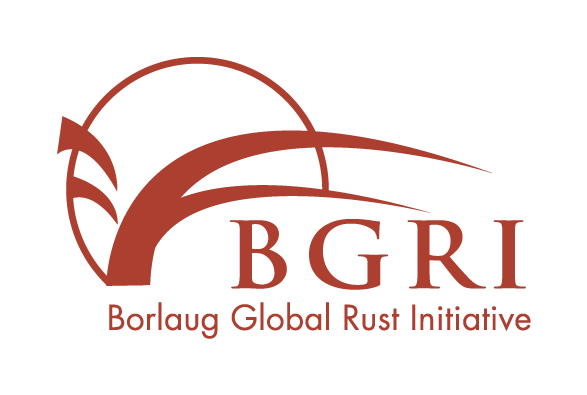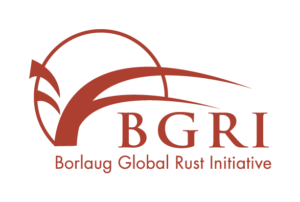Project Overview
The Durable Rust Resistance in Wheat (DRRW) project, a collaborative effort that began in April 2008 and ended in 2016, included 22 research institutions around the world and was coordinated by the Borlaug Global Rust Initiative at Cornell University.
The interdisciplinary and global approach to fighting plant disease had many facets including, objectives in: human capacity building; gender-responsive pre-breeding, breeding and seed delivery of resistant varieties; surveillance, monitoring and understanding the pathogen; improving screening facilities at “Ground Zero” in Kenya and Ethiopia; tracking alternate hosts; and advocacy.
The project sought to mitigate rust threats through coordinated activities to replace susceptible varieties with durably resistant varieties, create accelerated multilateral plant breeding platforms and deliver improved varieties through optimized developing country seed sectors.
The Delivering Genetic Gain in Wheat (DGGW) project built on the solid foundation of the DRRW, and was funded from 2016 to 2020.
Both projects were funded by the Bill & Melinda Gates Foundation and UK aid from the British people through the UK Department for International Development (DfID).
Impacts: 2008-2016
Human Capacity, Training & Gender
By 2016, the DRRW project had built an international community of hunger fighters that included more than 2000 scientists from 35 international institutions spread across 23 countries, united in the global fight against wheat disease, especially rust. This was up from the handful of scientists and four original partners (FAO, ICARDA, CIMMYT and Cornell) who had answered Norman E. Borlaug’s call to alarm at a meeting in Nairobi, Kenya, in 2005.
Under the DRRW, by 2016 more than 450 young scientists from around the world had been trained in breeding, screening, pathogen analysis, and field survey techniques and methodologies in training courses held in Kenya, Ethiopia, Nepal, India and Mexico. To further encourage young scientists, graduate students selected on a competitive basis delivered scores of plenary presentations next to their more senior colleagues, at the BGRI Technical Workshops, held annually.
To help improve the gender balance in the wheat research community, the DRRW instituted the annual Jeanie Borlaug Laube Women in Triticum (WIT) Early Career Awards in 2010. By 2020, 55 women researchers, from 20 countries, had been selected to receive support to participate in the annual Borlaug Global Rust Initiative (BGRI) meeting and in further education and training opportunities through the WIT awards.
To further strengthen the pipeline of young scientists engaged in scientific endeavors like wheat breeding and pathology, the DRRW instituted the annual Jeanie Borlaug Laube Women in Triticum Mentor Award to honor men and women who encourage and mentor female talent. From 2011 to 2020, 10 senior scientists from the DRRW community have been honored with the mentor award.
To insure that both men and women farmers had access to and adopted the new, improved varieties of rust resistant wheat, the DRRW involved farmers in “participatory variety selection” trials, in which farmers’ input — including input from women who do much of the planting, weeding, and post-harvest use — was considered.
Data generation, information sharing and open-access publications were important features of DRRW and the DGGW. Information continues to be shared through the globalrust.org website which is seen as a resource by the entire wheat community. The website includes links to the hundreds of peer-reviewed articles that have been published in scientific journals, many openly accessible.
Pre-breeding, Breeding and Seed Delivery
From 2008 to 2016, more than 81 varieties of wheat resistant to stem rust Ug99 had been released in 10 at-risk countries. Those countries — many of which were located in zones that were climate-variable, food-insecure and/or war-torn — included Egypt, Sudan, Ethiopia, Kenya, Iran, Pakistan, Afghanistan India, Bhutan, and Nepal.
As one example, during the project period Year-8 (October 2014-September 2015), an estimated 38,000 tons of Ug99 resistance wheat seed were made available for planting, which included 17,600 tons of 12 varieties in Kenya and 17,700 tons of at least 12 varieties in Ethiopia (including for 2,000 households that had lost their wheat harvest to stem rust epidemics). From 2011 to 2016, an estimated 880,000 tons of rust resistant seed was distributed to farmers and breeding stations. (In 2012 approximately 750,000 tons of resistant seed wasdistributed under the USAID Famine Seed Project. Average distribution for other years was 33,000 tons.) Since 2008, DRRW scientists increased the availability of effective race-specific resistance genes and molecular markers for their responsible stewardship. During the DRRW project, more than 40 plant genes were identified as sources of resistance to TTKSK (Ug99) and related variants. Of those, 30 have molecular markers and are in wheat breeders’ toolboxes.
To counteract the rust pathogens’ ability to mutate and overcome single resistance genes, the DRRW encouraged breeders to use germplasm responsibly, and only release varieties that deploy durable resistant rust gene combinations. To this end, the DRRW instituted the Gene Stewardship Award in 2011. Four teams received the award under the DRRW: Nepal, Australia, Ethiopia and Kenya.
Since 2008, breeders enhanced their understanding of complex adult-plant resistance (APR), pleiotropic multi-pathogen resistance genes, QTLs and breeding progress.
The pipeline of high-yielding, Ug99 resistant wheat germplasm developed through the Mexico-Kenya shuttle breeding was distributed worldwide through CIMMYT international nurseries and trials. Under the DRRW, the pipeline increased capacity and is more robust than in 2008.
Systematic technology generation including fast-track variety development and release, and adoption and testing of elite international lines for release or registration to replace susceptible varieties with varieties carrying APR genes.
Surveillance and Monitoring
Under the DRRW, a surveillance and monitoring network for crop pathogens was created that was unprecedented in scope or scale. By 2015, scientists from 37 countries were participating in rust surveillance through a globally coordinated, online surveillance community in contrast to 2007, when scientists from only two countries were involved in the network. By 2016, this network covered all major wheat-growing countries of Africa, Middle East and South Asia. Over 23,000 geo-referenced survey records and 5000+ rust isolates records have been collected, resulting in one of the most comprehensive plant disease databases. For the first time, important stem rust race groups, e.g., the Ug99 race group, have been successfully tracked in space and time. The successful system is now being applied to other crops and diseases. The rust surveillance and monitoring system for wheat is being used as a model for other crop / pathogen systems, notably Maize Lethal Necrosis.
A dynamic community has been built around surveillance activities. A network of partnerships spanning the entire spectrum from advanced to basic research has contributed to the overall success of the surveillance system and improved knowledge through increasing use of cutting-edge technologies.
Expanded use of molecular diagnostics and genomics is providing new insights into pathogen population genetics, evolution and migration. Advanced spore dispersal and epidemiology modeling provide an improved understanding of migration pathways and permit the deployment of improved early warning systems.
Rust surveillance and monitoring capacity were particularly improved in Ethiopia, a country well on its way to having one of the most comprehensive rust monitoring systems in the world. Surveillance and pathotyping facilities are fully functional there. Advanced early warning systems have been developed.
Early detection and rapid response to race TKTTF (Digalu race) illustrate the functionality of the surveillance system.With the improved capacity of the international pathogen surveillance and monitoring network, an outbreak of stem rust was detected in late December 2014 in Ethiopia. Because of early detection and subsequent rapid identification, researchers confirmed that this was a new stem rust race, labelled TKTTF or Digalu race, and not part of the Ug99 race group. Nonetheless, wheat varieties in the international breeders’ pipeline with resistance to TKTTF were identified and subsequently distributed to at-risk zones in Ethiopia and deployed in time for the 2015 planting season. This rapid response effectively thwarted what could have been a major epidemic and protected farmers’ yields in parts of Ethiopia in 2015 and 2016. The world cannot afford to be complacent because the threat is still there: as of 2016, this new race was confirmed in nine countries — Turkey, Iran, Lebanon, Egypt, Ethiopia, Georgia, Azerbaijan, Eritrea and Yemen.
East Africa Screening Facilities
Under the DRRW, a world-class phenotyping platform was established at the Kenya Agriculture & Livestock Research Organization (KALRO), in Njoro, Kenya, for screening against stem rust races of the Ug99 lineage. This facility continues to play a vital role in evaluating global wheat germplasm; facilitating pre-breeding, testing and release of rust resistant varieties in the CIMMYT-Kenya shuttle breeding program; pathogen surveillance; and gene discovery and characterization studies.
From 2006 to 2016, over 400,000 accessions of bread wheat, durum wheat and barley from 25 countries were screened in international screening nurseries in Kenya and Ethiopia. The capacity of these East African “Ground Zero” nurseries was virtually non-existent in 2005. Screening operations are carried out twice a year with (as of 2016) the capacity to evaluate 50,000 lines annually from 25 countries and institutions worldwide with information provided to collaborators.
Phenotyping platforms are an integral component in the development and release of stem rust resistant germplasm globally. As of 2016, 29 partners from 24 countries were screening cereal germplasm in the East African rust nurseries: from North America, the USDA, NDSU, Cornell, AAFC, University of Alberta, and CIMMYT; from Europe, Hungary; from Australia, the University of Sydney and CSIRO; from South America, Argentina, Uruguay, Paraguay and Brazil; from Africa, Kenya, Ethiopia, South Africa, Uganda, Egypt and Morocco; from Asia, India, China, Nepal, Bangladesh, Pakistan, Afghanistan, Bhutan; and from the Middle East, Iran, Turkey and ICARDA.
During the DRRW project, the Central Asian countries of Tajikistan, Kazakhstan, and Uzbekistan also submitted germplasm for screening.
Under the DRRW, facilities at the Wheat Research Center of Excellence at the Kulumsa Agricultural Research Center in Ethiopia were improved to include the mechanization of the wheat breeding program with tractors, combines, training for their maintenance and upkeep, and the establishment of irrigation infrastructure that enabled off-season seed multiplication. These improvements were in collaboration with EAAP, CIMMYT, and EIAR.
A greenhouse and head house at the Ambo Plant Protection Center in Ethiopia was constructed with the concurrent development of routine pathoytpe analyses, and the rearing of clean, uncontaminated inoculum for field screening activities.
Seed cold-room storage was constructed to enable long-term, safe storage of germplasm resources for the breeding programs at KARC and at the Debre Zeit Agricultural Research Center in Ethiopia, and for the safe storage of nuclear (pre-breeding, etc.) quantities of seed for multiplication.
Project Duration
2008-2016
Funded by
Bill & Melinda Gates Foundation
UK Department for International Development
Background
Sounding the Alarm on Global Stem Rust
An Assessment of Race Ug99 in Kenya and Ethiopia and Potential for Impact in Neighboring Regions and Beyond





